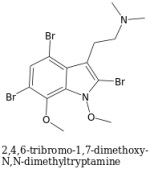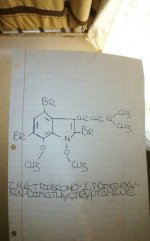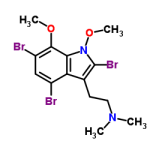entheogenic-gnosis
Rising Star
I came across this compound in my general research and was instantly intrigued, specially because of some of this compounds potential applications.
This tryptamine compound is present in aquatic invertebrates and is also known as "Convolutindole A"
2,4,6-tribromo-1,7-dimethoxy-N,N-dimethyltryptamine as well as other brominated tryptamine compounds like 5-bromo-DMT are common in some sea invertebrates and are being investigated for medical potential.
..."This chemical was tested for its ability to kill parasitic nematodes, It was found to be more effective than levamisole, a synthetic drug used to kill parasitic worms and to treat colon cancer".-Wikipedia
I heard that 5-bromo-DMT was also being investigated for anti-cancer research, but was also found to easily reduce to dimethyltryptamine. 5-bromo-DMT is found in a sea invertebrate as well.
Like lespedamine the NH group of the pyrrole ring of Convolutindole A has a methoxy group connected to it, as well as an additional methoxy group at position 7 and bromine atoms at 2, 4 and 6, a fascinating compound...
-EG
This tryptamine compound is present in aquatic invertebrates and is also known as "Convolutindole A"
2,4,6-tribromo-1,7-dimethoxy-N,N-dimethyltryptamine as well as other brominated tryptamine compounds like 5-bromo-DMT are common in some sea invertebrates and are being investigated for medical potential.
..."This chemical was tested for its ability to kill parasitic nematodes, It was found to be more effective than levamisole, a synthetic drug used to kill parasitic worms and to treat colon cancer".-Wikipedia
I heard that 5-bromo-DMT was also being investigated for anti-cancer research, but was also found to easily reduce to dimethyltryptamine. 5-bromo-DMT is found in a sea invertebrate as well.
Like lespedamine the NH group of the pyrrole ring of Convolutindole A has a methoxy group connected to it, as well as an additional methoxy group at position 7 and bromine atoms at 2, 4 and 6, a fascinating compound...
-EG





 Use Chemspider you just need to dump the compound name into the search bar.
Use Chemspider you just need to dump the compound name into the search bar.
